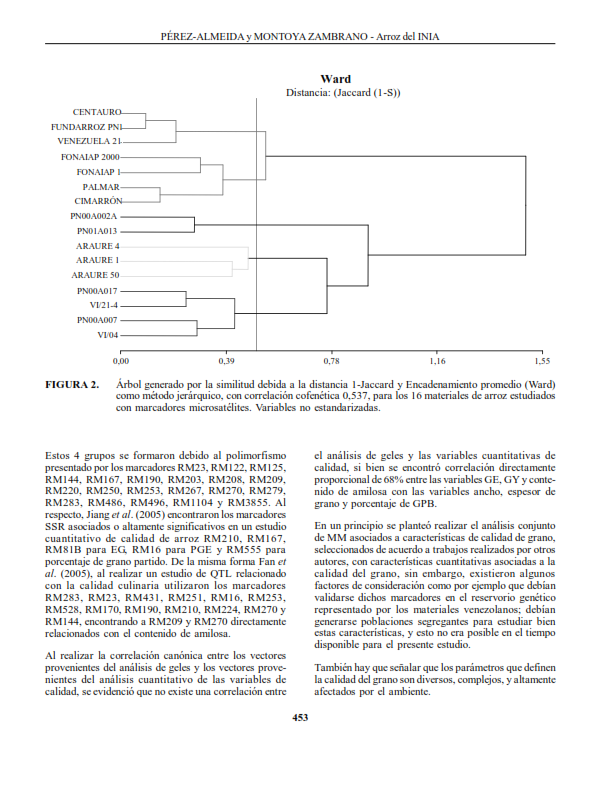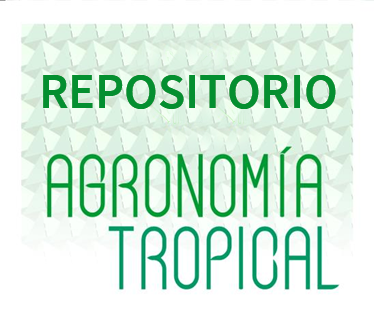Calidad del grano y variabilidad genética de variedades y líneas de arroz del Instituto Nacional de Investigaciones Agrícolas (INIA)
Resumen
La calidad del grano de arroz, Oryza sativa L., considera aspectos molineros, culinarios, de apariencia y nutricionales. En este trabajo se realizó la caracterización morfológica y molecular de 16 materiales de arroz del Instituto Nacional de Investigaciones Agrícolas (INIA), con énfasis en calidad del grano, utilizando marcadores microsatélites (SSR). Los caracteres evaluados incluyeron longitud (L), ancho y espesor del grano, porcentaje de granos enteros (PGE), yesosos (GY), panza blanca (GPB) y el contenido aparente de amilosa. Por asociación de componentes principales se encontró que 3 factores explicaron 75% de la variación total. Los materiales utilizados en este ensayo presentaron grano fino largo, comportamiento intermedio en calidad molinera, mientras que su calidad culinaria, exceptuando 2 variedades de origen italiano, mostraron una composición de amilosa mayor de 20%, acorde con lo exigido por el mercado nacional. Para analizar la variabilidad genética se utilizaron 48 microsatélites previamente asociados a caracteres de calidad del grano, encontrando que sólo 20 presentaron bandas polimórficas (porcentaje de loci polimórfico 40%) en estos materiales y detectando 43 alelos, con un número promedio de alelos por marcador de 2,26. A los datos moleculares se les realizó un análisis de correspondencia múltiple encontrando que los 3 primeros factores explicaron 70,6% de la variación total, y por análisis de conglomerados usando la distancia 1-Jaccard y encadenamiento promedio de Ward se obtuvo la formación de 4 grupos. Bajo las condiciones de este estudio no se demostró correlación entre las características cuantitativas de calidad de grano y los patrones alélicos obtenidos por SSR.
Descargas
Citas
• Aluko, G., C. P. Martinez, J. Tohme, C. Castano, C. Bergman and J. H. Oard. 2004. QTL mapping of grain quality traits from the interspecific cross Oryza sativa x O. glaberrima, Theor. Appl. Gen. 109:630-639.
• Bao, S., H. Corke and M. Sun. 2002. Microsatellites in starch synthesizing genes in relation to starch physicochemical properties in waxy rice (Oryza sativa L.). Theor Appl. Genet.105:898 905.
• Centro Internacional de Agricultura Tropical (CIAT). 1989. Evaluación de la calidad culinaria y molinera del arroz: Guía de estudio. 75 pp.
• Chaudhary, R. C. and D. V. Tran. 2001. Specialty rice of the World: a prologue. In: Chaudhary R.C., D. V. Tran and R. Duffy (Edit.). Specialty rice of the World: Breeding, production and marketing. Science Publishers Inc, Enfield, USA. pp. 3-12.
• Cheng, Z., G. G. Presting, C. R. Buell, R. A Wing and J. Jiang. 2001. High-resolution pachytene chromosome mapping of bacterial artificial chromos omes anchored by genetic markers reveals the centromere location and the distribution of genetic recombination along chromosome 10 of rice. Genetics 157:1.749-1.757.
• Fan, C., X. Yu, Y. Xing, C. Xu, L. Luo and Q. Zhang. 2 00 5. The main effect s, ep is ta tic effect s and environmental interactions of QTL on the cooking and eating quality of rice in a doubled haploid line population. Theor. Appl. Genet. 110:1.445-1.452.
• GRAMENE. 2007. Oryza. Documento en línea. Disponible en: https://bitly/32WZv1U Fecha de consulta: 14/02/2006.
• Gu, X. Y., S. F. Kianian and M. E. Foley. 2004. Multiple loci and epistases control genetic variation for seed dormancy in weedy rice (Oryza sativa). Genetics 166:1.503-1.516.
• Hirano, H. Y. and Y. Sano. 2000. Comparison of Waxy gene regulation in the endosperm and pollen in Oryza sativa L. Genes Genet Syst. 75:245 249.
• Ilarraza, D. 2002. Efectos del genotipo y tiempos de almacenamiento sobre la calidad culinaria de líneas experimentales de arroz (Oryza sativa L). Tesis de pregrado. Universidad Central de Venezuela. Facultad de Agronomía. Maracay Venezuela. 80 pp.
• InfoStat. 2004. InfoStat software Estadístico. Versión 1.1. Universidad de Córdoba, Argentina.
• Jiang, G., X. Hong, C. Xu, X. Li and Y. He. 2005. Identification of quantitative trait loci for grain appearance and milling quality using a doubled haploid rice population. J. of Integrative Plant Biology 47:1 391-1 403.
• Juliano, B. and C. Villareal. 1993. Grain quality evaluation of world rice. International Rice Research Institute (IRRI). Philippines, 205 pp.
• Lanceras, J., Z. Huang, O. Naivikul, A. Vanavichit, V. Ruanjaichon and S. Tragoonrung. 2000. Mapping of genes for cooking and eating qualities in Thai jasmine rice (KDML105). DNA Res. 7:93-101.
• León, J. L. y R. Carreres, 2002. Calidad del arroz: criterios para una adecuada valoración. Vida Rural 145:38-40.
• Livore, A. 2004. Calidad Industrial y culinaria del arroz. Revista IDIA XXI 6:190-194.
• Lu, C. F., L. H. Shen, Z. B. Tan, Y. B. Xu, P. He, Y. Chen and L. H. Zhu. 1997. Comparative mapping of QTLs for agronomic traits of rice across environments by using a doubled haploid population. Theor. Appl. Genet. 94:145-150.
• Martínez, C. P., S. Carabali, M. C. Duque y J. Silva. 2002. Progreso genético para calidad de grano de arroz (Oryza sativa) mediante selección recurrente. In: Mejoramiento poblacional, una alternativa para explorar los recursos genéticos del arroz en América Latina. Guimaraes E.P. (Ed.) Centro Internacional de Agricultura Trop. Cali, Colombia. pp. 296-317.
• Montoya, M., N. Rodríguez, I. Pérez-Almeida, J. Cova y L. Alemán. 2007. Caracterización morfológica de 13 variedades de arroz venezolanas. Agronomía Trop. 57(4):299-311.
• Páez, O. 2004. El Cultivo de arroz en Venezuela. Insti- tuto Nacional de Investigaciones Agrícolas (INIA). Alfredo Romero (Ed.). Serie Manuales de Cultivo INIA Nº 1. Maracay. 202 pp.
• Picca, A., M. Helguera, N. Salomón y A. Carrera, 2004. Marcadores Moleculares. In: Biotecnología y Mejoramiento Vegetal. Parte II. Herramientas básicas. Ediciones INTA. Echenique, V., Rubinstein, C., y L. Mroginski (Eds.). Parte II, Cap. 4 pp. 61 68.
• Septiningsih, E. M., J. Prasetiyono, E. Lubis, T. H. Tai, T. Tjubaryat, S. Moeljopawiro and S. R. McCouch. 2003. Identification of quantitative trait loci for yield and yield components in an advanced backcross population derived from the Oryza sativa variety IR64 and the wild relative O. rufipogon. Theor. Appl. Genet. 107:1.419-1.432.
• Singh, K., T. Ishii, A. Parco, N. Huang, D. S. Brar and G. S. Khush. 1996 . Centromere mapping and orientation of the molecular linkage map of rice (Oryza sativa L.). Proc. Natl. Acad. Sci. 93:6 163-6 168.
• Tan, Y., M. Sun, Y. Xing, J. P. Hua, X. L. Sun, Q. Zhang and H. Corke. 2001. Mapping quantitative trait loci for milling quality, Protein content and color characteristics of rice using a recombinant inbred line population derive from and elite rice hybrid. Theor. Appl. Genet. 103:1 037-1 045.
• Tan, Y. F., J. X. Li, S. B. Yu, Y. Z. Xing and C. G. Xu. 1999. The three important traits for cooking and eating quality of rice grains are controlled by a single locus in an elite rice hybrid Shanyou 63. Theor. Appl. Genet. 99:642-648.
• Temnykh, S., W. D. Park, N. M. Ayres, S. Cartinhour, N. Hauck, L. Lipovich, Y. G. Cho, T. Ishii and S. R. McCouch. 2000. Mapping and genome organization of microsatellite sequences in rice (Oryza sativa L.). Theor. Appl. Genet. 100:697-712.
• Temnykh, S., G. DeClerck, A. Lukashova, L. Lipovich, S. Cartinhour, and S. McCouch. 2001. Computational and experimental analysis of microsatellites in rice (Oryza sativa L. ): frequency, length variation, transposon associations, and genetic marker potential. Genome Research 11:1 441-1 152.
• Thomson, M. J., T. H. Tai, A. M. McClung, X. H. Lai, M. E. Hinga, K. B. Lobos, Y. Xu, C. P. Martinez and S. R. McCouch. 2003. Mapping quantitative trait loci for yield, yield components and morphological traits in an advanced backcross population between Oryza rufipogon and the Oryza sativa cultivar Jefferson". Theor. Appl. Genet. 107:479-493.
• Wang, Z., F. Zheng, G. Shen, J. Gao, D. Snustad, M. Li, L. Zhang and M. Hong. 1995. The amylose content in rice endosperm is related to the post transcriptional regulation of the waxy gene. Plant J. 7:613-622.
• Webb, B. D. 1991. Rice quality and grades. In: Rice Utilization, Volume II. Luh B.S. (Ed.) Van Nostrand Reinhold AVI Book, New York. pp. 89-119.
• Yamanaka, S., I. Nakamura, K. N. Watanabe and Y. Sato. 2004. Identification of SNPs in the waxy gene among glutinous rice cultivars and their evolutionary significance during the domestication process of rice. Theor. Appl. Genet. 108:1 200-1 204.
• Yan, C., G. Liang, F. Chen, X. Li, S. Tang, C. Yi, S. Tian, J. Lu and M. Gu. 2003. Mapping quantitative trait loci associated with rice grain shape based on an indica/japonica backcross population. Yi Chuan Xue Bao 30:711-716.
• Yoshida, S., M. Ikegami, J. Kuze, K. Sawada, Z. Hashimoto, T. Ishii, C. Nakamura and O. Kamijima. 2002. QTL analysis for the plant and grain characters of sake brewing rice using a doubled haploid population. Breeding Sci. 52:309-371.
• Zhuang, J. Y., Y. Y. Fan, Z. M. Rao, J. L. Wu, Y. W. Xia and K. L. Zheng. 2002. Analysis on additive effects and additive-by-additive epistatic effects of QTLs for yield traits in a recombinant inbred line pop u la t ion of rice. T heor. Appl. Genet . 105:1 137-1 145.





